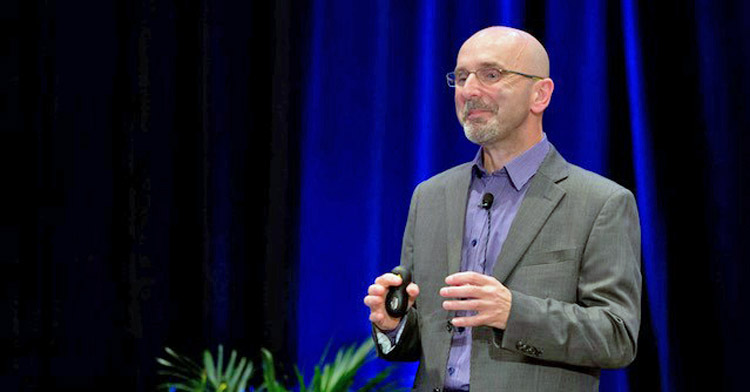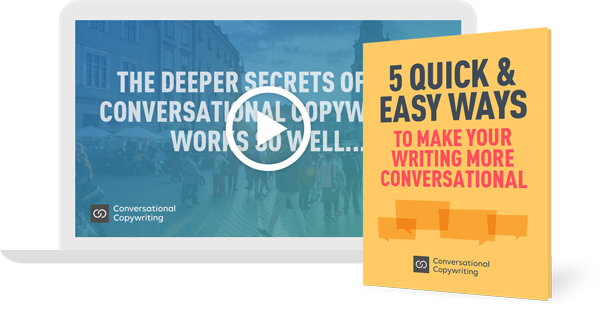In this post I get to interview Steve Slaunwhite… fellow copywriter, author, speaker and trainer.
It seems like I’ve known Steve forever. But I’m guessing it’s closer to the 15-year mark.
Over the years he’s a been a good friend. And I think we agree on most things when it comes to our work as copywriters.
But there is a point of difference. While much of my experience has been in B2C copywriting, Steve has built up a huge reputation as an expert in B2B copywriting.
That’s a big part of why I reached out to him for this interview.
I get a lot of questions about the role of conversational copywriting in B2B, and I figured Steve would be the best person to answer them.
Let’s get started with the interview…
Nick: First up… the simplest and most obvious question… Do you think conversational copywriting works for B2B copywriting? Just in broad terms. The 30,000 foot view.
Steve: Short answer: Yes. In my workshops, I often tell marketers to imagine copywriting as a meeting you’re having with your prospect or customer. As a marketer, you obviously want that meeting to go well! You want to say the right things. Make the best impression. Motivate the prospect or customer to take the next step.
Being genuine and conversational plays a huge role in that dynamic — regardless of the form your “meeting” takes: brochure, web page, email, ad, etc.
Nick: That pretty much aligns with what I’ve been telling people. But it’s reassuring to hear it from someone who has been immersed in the B2B space for so long.
Let me add another layer to that question.
What about conversational copywriting as it applies to selling to the “sophisticated buyer”? For example, business owners, lawyers, realtors, dentists, HR managers, etc.
Is there a danger that an audience that is so thoroughly used to formal business language might be put off by a copywriting approach that uses everyday language? Might it feel “not serious enough”?
Steve: Let me answer that by using another analogy. Imagine two dentists talking about billing software at a dental conference. Sure, they’re going to use short-hand lingo, buzzwords and so forth. But beyond that, they’re not going to talk in a formal or even overly-technical manner. They’re going to have a conversation! The trick for marketers and copywriters — especially those who target business people and professionals — is to write in the same conversational style you’d imagine your customers speaking.
For example, one of my favorite headlines is from Less Accounting: “Accounting Software for Business Owners Who Dislike Bookkeeping.”
Notice how candid and conversational that line of copy is. It’s easy to imagine a business owner using those same words to describe the software to a colleague.
Nick: I really like that headline! I’m going to use it as an example of good conversational copywriting.
Sometimes people tell me that some B2B conversations have to use fancy, industry-specific terms and phrases. And that discussions inevitably become technical and pretty much incomprehensible to outsiders.
I don’t buy that. I think pretty much any technical discussion can be translated into everyday, conversational language. What do you think?
Steve: It depends on the audience. You and I, as marketers, will naturally use marketing-specific vocabulary when chatting. I can say “landing page conversion rates” without having to define that for you.
That being said, using jargon specific to a target audience — say, Realtors — doesn’t necessarily take the copy out of the realm of conversation. It simply becomes part of the conversation. The challenge for marketers and copywriters is to recognize that and not let the writing become stiff and formal.
Nick: When people challenge me about the use of conversational copywriting for B2B, I usually make the point that at some point – usually at many points – every B2B negotiation involves people getting together and having a real conversation.
In that sense, B2B is already more naturally conversational than B2C… which often just involves the one-way broadcast of a sales messages.
B2B is conversational almost by definition! Or am I oversimplifying that?
Steve: I couldn’t agree more! In most B2B sales, there’s a point in the process where, as you say, a “real conversation” happens. That could be a call with the inside sales person or a meeting with a sales rep.
Imagine a dentist running a large clinic and having a conversation with someone from a billing software company. That’s going to be a real human-to-human conversation. And if you follow the logic I mentioned earlier — that every marketing piece is a meeting with your prospect or customer — then it makes sense for your copy to be similarly conversational.
Nick: A potential challenge I see is the length of the sales cycle, and the number of people involved.
In B2C, a complete sales process might comprise a series of 3 emails and a sales page. It’s pretty easy to create and maintain a consistent conversational voice across those elements. And then repeat it across other campaigns and platforms.
But in B2B, where the sales cycle is usually way longer, with many more people involved… how do you maintain a single conversational voice? Do you have experience with making that work?
Steve: Well, I teach this to companies. So one of the main goals of my workshops is to help everyone — marketing, sales — to take a conversational approach with their writing.
But the point is not to have everyone write in exactly the same way. Conversational copywriting along the sales cycle can feature different voices. A brochure doesn’t have to sound exactly like the email campaign, just as two people at a meeting aren’t going to speak in exactly the same way.
You may disagree, Nick, but I think it’s not sustainable or even desirable to “maintain a single conversational voice”. Having varied conversational styles throughout the sales process works better, in my opinion.
Nick: OK… so let me push back on that a little. I agree that the various voices within a company shouldn’t all sound exactly the same. That just wouldn’t feel natural.
But shouldn’t I still be able to recognize a company’s unique voice, underneath those differences? Shouldn’t I be able to feel, “Yep, that sounds like the voice of Acme Dental Services!” Even when that voice is expressed in different ways by different people at different points in the cycle?
Steve: I think we’re on the same page, Nick. A company should have a recognizable voice in their marketing copy, but with elbow room for some variation. We’re not talking big differences here. A more familiar and personal style for emails, for example, while a more explanatory style for brochures. Some variations in individual voices, but always sounding like it’s coming from the same team.
Nick: Thank you. I really appreciate your thoughts on this. And I love that we don’t absolutely agree on everything! I should have reached to interview you sooner. Do you have any final thoughts you’d like to share?
Steve: Learn. Practice. Learn some more. Writing conversationally may seem easy but it can often be a challenge because the old-school rules of “business-like” and “hard sell” still haunt us. The payoff is that, in my experience, conversational marketing copy just works better. I think it always has.
You can reach Steve through his site at steveslaunwhite.com
Note: If you want to get some professional-grade training in the craft of conversational copywriting, find out about the Conversational Copywriting course here…


Thanks, Nick for pointing me to this interview. It answered a few questions, and those answers helped me to feel more at ease with my choice to go into B2B for technology.
Well, for one of my revenue streams, anyway. Chatbots and conversation design seems like a lot of fun too!
Thanks for referring me to this interview, Nick. Put my mind at ease.
I enjoyed the conversational interview. I thought it was a great learning experience reading how the… voice [of the company] is expressed in different ways by different people at different points and …every marketing piece is a meeting with your prospect or customer.